| Fukuoka
POW Camp #4 Moji Camp and Kokura Hospital |
Main Index Page List of All Japanese Camps About Us
|
Moji POW
Camp and Kokura Military Hospital: Note: Partial records and photographs were found in RG331 but were gathered under Fukuoka #22 camp. Kokura Military Hospital research is courtesy of Mark Kelso, of Galveston, Texas. His grandfather died at this hospital, just south of the Moji camp. See Jim Erickson's webpage on the "Three Hospitals" -- Moji Ward, Kokura Military Hospital, and Shimonoseki Quarantine Station. Location: Satellite map Aerial (Mar. 1947; courtesy of Japan Map Archives) Aerial of Shimonoseki - Kokura - Moji area (Kanmon Strait, heavily mined during the war) See town maps below for additional maps. Timeline: 1942 Nov 28: Established as Moji Dispatched Camp of Yawata Temporal POW Camp at Kusunoki-cho, Moji City 1943 Jan 1: Reorganized to be Moji Branch Camp of Fukuoka POW Camp Group 1943 Mar 1: Renamed as Fukuoka #4 Branch Camp Camp Photographs - a series of mostly propaganda pictures showing the facilities. Description: Investigation Report (PDF) - with photographs Jim Erickson's site on Moji 4-B Japanese Camp Staff Original Staff Roster, English and Japanese Interviews: Source: Keith J. Clarke Partial story of Arthur George Clarke, Royal Artillery captured on Java. Arrived on Dai Nichi Maru. Clarke perished at the Moji camp, 19 Dec 1942. Special Link: Story of Lt. Walter A. Kelso Jr., who died at Kokura Military Hospital, 04 Feb 1945. MEMORIAL: It has long been our desire to see a memorial built at Moji Port, the "Grand Central Station" for Allied POWs entering Japan via hellships. Per a request to the U.S. Congress by the American Defenders of Bataan and Corregidor Memorial Society, March 2021: "Encourage the Government of
Japan to create a memorial for the Allied POWs of WWII at the
Port of
Moji on Kyushu where most of the POW hellships docked and
unloaded
their sick and dying human cargo."
|
Primary
Labor
Use: Limited medical facilities for POWs. A number of the medics were forced to work as stevedores for Kanmon Harbor Transport Company. POWs arrived on numerous hells ships and most of the very sick were taken to this camp where the majority perished. For example, Singapore Maru, Dai Nichi Maru, Brazil Maru (ex Oryoku Maru). Rosters: Total = 305 POWs (107 British, 102 American, 91 Dutch, 5 other nationalities; 191 deaths) American POW Roster Aug 1945 (Moji 4-B) Many of the men who perished here are listed under the Hakodate #1 by the Japan POW Research Network. Deceased Yanks buried in charnel (common grave)- These men perished in Moji as a direct result of mistreatment on the Oryoku Maru - Brazil Maru - Enoura Maru saga in Dec. 1944. FUK-04 Moji Death List 1945-11-15 (original documents) British dead ex Singapore Maru British Dead en route on the Singapore Maru- Source: Imperial War Museum British Survivors of the Singapore Maru who survived the Shimonoseki Quarantine Station (across the straits from Moji) Picture of common grave and crematorium Original rosters - British, Australian, Canadian, American, and also British deaths (Dainichi Maru) FUK-04 Rosters 1946-02-16 Original Deceased List Affidavits: Fukuoka #4 Moji affidavits (Source: RG389 Box 2123) War crimes affidavit of Navy Lt (Doctor) L. Bland Williams descibes the gross conditions of the camp (YMCA building) and careless disregard by the Japanese. Affidavit of Borrie - describes maltreatment of sick & injured Extract of 1st Lt A.W. Balfanz- notes arrival on Brazil Maru and death rate. Affidavit of British doctor Berkeley- describes in detail conditions and treatment of the prisoners. Godfrey Ames diary (RG 407 Box 123) - Personal and Official Notes, Diary, from 10 Nov 1942; Capt Godfrey R. Ames, Btry C, 60th CA (AA), Cabanatuan, N.E., P.I. Contains: Roster for Battery D and citation awards; recommendations for awards; Cabanatuan POW Camp. Total of ten books, only Books 1~4 imaged. |
Town Maps |
|
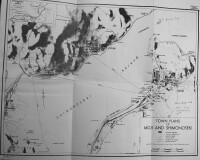 |
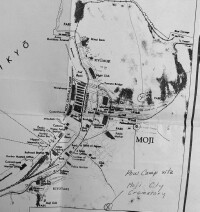 |
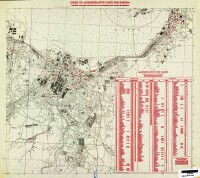 US military district map, 1945 |
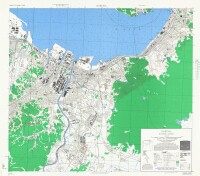 US military map, 1945 |
Camp Layout |
|
 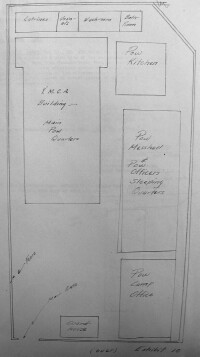 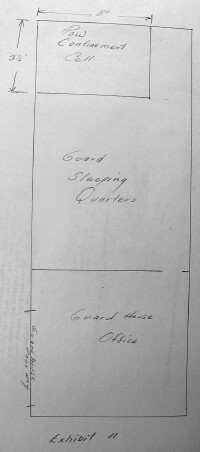 |
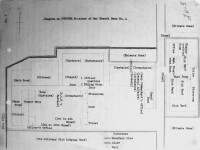  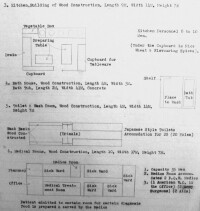   |